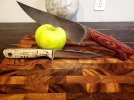Fishcharmer
Gold Member
- Joined
- Feb 1, 2020
- Messages
- 285
A couple of months ago, I had a conversation with @Cohutta about the relatively new 8670 steel. As my knife use runs more to the hunting, general purpose, and EDC realm, rather than hard use bushcraft, he was curious what my impressions were of it (from the user end), and specifically how it compared to A2. As a result of that conversation, I decided run a little test.
Let me mention a few things first:
The Knives
For this test I chose four knives:
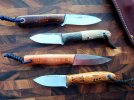
I wanted the edge on each knife to be identical, so I sharpened each at 20 degree down to .5 micron on a Wicked Edge. This is a much finer edge than I would normally take a hunting knife, as you lose some “bite” when field dressing, and can also have some issues with over-cutting, and edge retention. However, since part of the comparison was to be a test of edge stability, and retention, I wanted to stress the knives there a little more..
The Test
The test consisted of processing game(primarily deer) from field-dressing to vacuum-bagging. Normally, I would use different knives in each step of this process, but we used these four exclusively. Over the course of 4 weeks we worked up 22 deer(ours, friends, family,) 1 bear(neighbors), 13 geese, and 5 ducks. In addition, we used them for just about every other little cutting task we encountered while hunting(ex: cutting zip ties on temp waterfowl blind, and whittling a field ramrod to clear snow from a rifle barrel).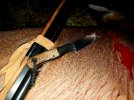
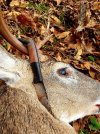
I am very diligent about stropping my knives. For the purpose of this comparison though, we neglected stropping completely for the first stage of this test. We basically cut until we couldn’t anymore, resharpened the edges to a pristine condition, and then stropped as necessary from that point on.
We made it a point to be hard on the edges. We went over and above what would be considered normal(or wise) use. We intentionally raked bones, cut through ribs, scraped ball joints, and batoned through pelvic bones. I’d be lying if I said their weren’t a few teeth-gritting winces along the way. We also neglected oiling the knives after cleaning(during the first week of the test) to see how each steel reacted.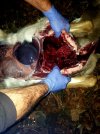

Results
We were able to see a few differences between these two steels based on the paces we put them through.
Conclusions
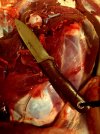
One thing I can say for sure is that both A2, and 8670 are top notch, hard use knife steels. They both do what you ask them to do(and then some). But, were we able to answer which steel is better?
It depends...
What tasks will you be using the knife for? How harshly will you treat it? How often will you use it? how frequently will you oil, or strop it?
If I has looking for a heavy duty Bushcraft Knife, Camp Knife, or Chopper...8670 without thinking twice. It’s approaching indestructible, and you can sharpen it on a rock.
If you are looking for an EDC that doesn't see hard use, but you want it to be hair popping sharp when you need it...maybe look at A2.
I think both are outstanding as hunting knife steel, but which you choose will depend on how diligent you are with keeping up the edge, and after use care...For a hunting knife, I Personally like what A2 offers, but will continue to use my 8670 knives when I head to the woods..
I'm really interested in hearing your thoughts on the differences you all have seen between these two steels. Regards, Fish
Let me mention a few things first:
- I am a knife enthusiast, not a knife maker. I know next to nothing about metallurgy, heat treatments, blade design, ect.. I know which end of the knife to hold(usually), and how to operate it safely(usually)...that’s about the extent of it.
- This test was not comprehensive, nor especially scientific. The controls were too rudimentary, the variables too numerous, and the data points too few to arrive at any definitive conclusions. It was a very narrow test undertaken to satisfy my own curiosity.
The Knives
For this test I chose four knives:
- FF Pack Rat 1/8 8670
- FF Toboggan 1/8 A2
- Cohutta Mini Strebig 3/32 A2
- FF Toboggan 3/32 8670

I wanted the edge on each knife to be identical, so I sharpened each at 20 degree down to .5 micron on a Wicked Edge. This is a much finer edge than I would normally take a hunting knife, as you lose some “bite” when field dressing, and can also have some issues with over-cutting, and edge retention. However, since part of the comparison was to be a test of edge stability, and retention, I wanted to stress the knives there a little more..
The Test
The test consisted of processing game(primarily deer) from field-dressing to vacuum-bagging. Normally, I would use different knives in each step of this process, but we used these four exclusively. Over the course of 4 weeks we worked up 22 deer(ours, friends, family,) 1 bear(neighbors), 13 geese, and 5 ducks. In addition, we used them for just about every other little cutting task we encountered while hunting(ex: cutting zip ties on temp waterfowl blind, and whittling a field ramrod to clear snow from a rifle barrel).


I am very diligent about stropping my knives. For the purpose of this comparison though, we neglected stropping completely for the first stage of this test. We basically cut until we couldn’t anymore, resharpened the edges to a pristine condition, and then stropped as necessary from that point on.
We made it a point to be hard on the edges. We went over and above what would be considered normal(or wise) use. We intentionally raked bones, cut through ribs, scraped ball joints, and batoned through pelvic bones. I’d be lying if I said their weren’t a few teeth-gritting winces along the way. We also neglected oiling the knives after cleaning(during the first week of the test) to see how each steel reacted.


Results
We were able to see a few differences between these two steels based on the paces we put them through.
- Edge Retention: This one was not especially close, and the biggest difference I saw between these two steels. Although 8670 holds a very good edge (The 1/8th 8670 processed 2 deer start to finish, without stropping, before it needed resharpening...The last bit was a little rugged), it was ready for resharpening in about half the amount of cutting the A2 got through. The 3/32 A2 could still shave hair after processing a deer start to finish! During the second part, when we were stropping diligently, the 8670 needed stopping sooner, and more frequently than the A2. It also seemed like we could just get A2 “sharper”.....Winner: A2
- Toughness: I’m concerned we pulled a few punches on this part of the test, but even given that there was enough of a difference between these two to declare 8670 the clear winner. We did things with the 3/32 8670 that you shouldn't do with a hunting knife, and didn’t so much as roll an edge. It really was impressive. All of you who have used A2 know how tough it is, but we still managed a couple dings, and rolled a couple of edges(no chips).......Winner: 8670
- Sharpen-ability : There are trade-offs in everything. If you’ve got a knife that holds a fantastic edge, chances are it’s going to be a bit harder to sharpen. That was the case here. The 8670 is insanely easy to resharpen. If you don’t let the edge get to far gone, a few passes on the strop, and it’s working sharp. I have never considered A2 a difficult steel to sharpen, especially when compared to some of the “super steels”, but it doesn’t match 8670 in this department. I did find that once we got to the second part of the test, and were diligently stropping, there was not as much difference between the two steels(but there was some). If you let both get to a sad state of dullness, it took much longer to get A2 back to sharp-sharp......Winner: 8670
- Corrosion Resistance: We didn’t let this part of the comparison get out of hand, but we didn’t need to. It was pretty clear that A2 holds a decisive advantage. If you dig a knife that patinas with ease; 8670 is the way to go. If you want your knives to look newer longer; go with A2........Winner: A2
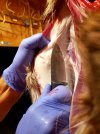
Conclusions

One thing I can say for sure is that both A2, and 8670 are top notch, hard use knife steels. They both do what you ask them to do(and then some). But, were we able to answer which steel is better?
It depends...
What tasks will you be using the knife for? How harshly will you treat it? How often will you use it? how frequently will you oil, or strop it?
If I has looking for a heavy duty Bushcraft Knife, Camp Knife, or Chopper...8670 without thinking twice. It’s approaching indestructible, and you can sharpen it on a rock.
If you are looking for an EDC that doesn't see hard use, but you want it to be hair popping sharp when you need it...maybe look at A2.
I think both are outstanding as hunting knife steel, but which you choose will depend on how diligent you are with keeping up the edge, and after use care...For a hunting knife, I Personally like what A2 offers, but will continue to use my 8670 knives when I head to the woods..
I'm really interested in hearing your thoughts on the differences you all have seen between these two steels. Regards, Fish
Last edited:

